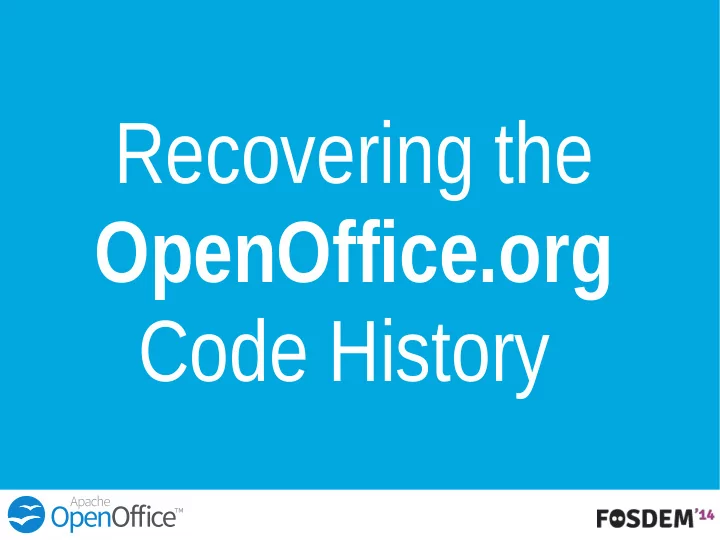

Recovering the OpenOffice.org Code History
Why Code History? ● first-hand reference on how code evolved ● when the developer knew most about it ● detailed references to external resources ● developers have limited memories ● original developers leave projects
OpenOffice Repositories History ● 1988-2000 Proprietary ● 2000-2003 CVS trunk-only ● 2003-2009 CVS with branches ● 2008-2009 Subversion ● 2009-2011 Mercurial ● 2011-2014 Subversion ● 2014-20XX Git (read-only now)
OpenOffice VCS Transition Losses ● 1988-2000 All history lost ● 2000-2003 CVS trunk preserved ● 2003-2009 CVS branches lost ● 2008-2009 SVN branches lost ● 2009-2011 HG mostly preserved ● 2011-2014 SVN still available ● 2014-20XX GIT look great
The Lost Heritage ● OOo repository changes dropped branches ● From 2003-2011 all development work was done on branches ➔ about 5000 CVS branches lost ➔ about 1000 SVN branches lost ➔ the Mercurial branches are not easily available
Why worry about lost branches? Branch before merge History-Preserving Merge
A small excursion Branch before merge History-Preserving Rebased Merge
OOo-Style Merging Branch before merge Branch-Crushing OOo-Style Merge
What was lost? Commits from branches were squashed: ● most commit messages were lost ● file-level change relationships was lost ● commit message ↔ changeset was lost ● authorship was lost / re-attributed
Chances to get the history back ● The CVS sub-repositories once were available as one rsync'able tarball ● the OOo SVN repository was available via svnsync ● the HG repositories were available unless they were integrated
Making them Usable dba CVS CVS CVS-SVN OOo-CVS framework converted to converted to converted to Tarball SVN SVN GIT graphics All-OOo GIT OOo-SVN with grafts OOo-SVN converted to and GIT a unified mailmap HG A OOo-HG HG B OOo-HG converted to GIT HG C
Problems of the CVS-History ● squashed branch-accumulated commits ● codebase only partially tagged ➔ branches have many missing files ➔ the conversion has to introduce “glue” commits ● many partial merges (for each file) – no proper merge commits
History Losing Partial Merges Branch before merge History-Crushing File-Based Merge
Problems of the CVS-History ● “resyncs” messed up branch histories ● originated from multiple CVS-Repos e.g. framework, graphics, gsl, ... ● some branch names were deleted ➔ there are “unnamed branches”
Problems of the SVN-History ● squashed accumulation of commits ● no proper merge commits ● “resyncs” messed up branch histories ● Most SVN branches are not yet connected to their CVS counterparts
Minor Problems of the HG-History ● many wrong author names ➔ can be solved with mail-mapping ● HG-Commit-Hashes were lost ➔ can be solved by a re-import
The Repository Histories HG SVN CVS
The HistOOory in GIT ● all former repositories were converted to GIT ● they have been merged into one archive (at http://people.apache.org/~hdu/HistOOory.zip) – all the code history is compressed into 2GB – it contains all branches, commits and files – except binary artifacts like GIFs, Templates, Fonts
What can be done with it? ● All former repositories are preserved ● All non-empty branches are preserved ● All commits can be researched individually ● Historical sources can be recreated ● Bad merging means “blame” doesn't work
Questions?
Recommend
More recommend